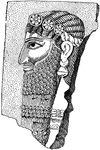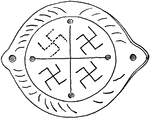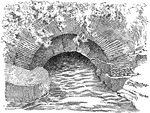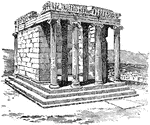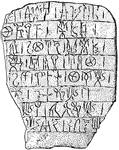
Cretan Writing
"A large tablet with linear script found in the palace at Gnossus, Crete. There are eight lines of writing…

Beginning of Written Language
"Below the pictured hieroglyphics in the first line is the same text in a simpler writing known as hieratic.…

The Moabite Stone
"Found in 1868 at Dîbân, east of the Dead Sea. The monument records the victory of Mesha,…

Stonehenge
An ancient monument located in England, composed of earthworks surrounding a circular setting of large…

Khufu
A Pharaoh of Ancient Egypt. He reigned from 2589 to 2566 BC, and is known for being the builder of the…

Merneptah
The fourth ruler of the Nineteenth Dynasty of Ancient Egypt, reigning from 1213 to 1203 BC.

The Great Pyramid of Giza
"The pyramid when completed had a height of 481 feet. It is now 451 feet high. Its base covers 13 acres.…

The Great Sphinx
"This colossal figure, human-headed and lion-bodied, is hewn from the natural rock. The body is about…
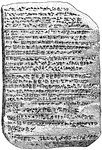
The Amarna Tablet
A series of correspondence on clay tablets between the Egyptian administration and its representatives…

Ramses II Seated
"A black granite statue of the youthful Ramses II. It is probably a faithful portrait. No better work…
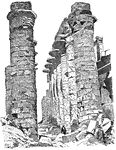
Central Avenue, Hall of Columns, Karnak
"The hall measures 170 feet deep by 329 feet broad. Its roof was supported by a central avenue of 12…
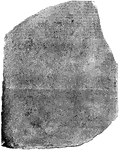
The Rosetta Stone, Front View
A fragment of an Ancient Egyptian text, which provided the key to the modern understanding of Egyptian…

Excavations at Nippur
"Nippur was the ancient 'Calneh in the land of Shinar.' Excavations here were conducted by the University…
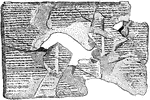
The Deluge Tablet
"Contains the narrative of the flood as pieced together and published by George Smith in 1872. There…
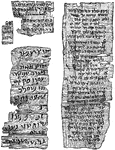
Ancient Hebrew Manuscript
"A papyrus of the first century A.D., containing the Ten Commandments. It was discovered in Egypt."—Webster,…

Rock Temple at Abu-Simbel
"The temple, built by Ramses II on the steep face of a cliff overlooking the Nile, has a facade containing…
An Assyrian Statue
"The king, a rude heroic figure, stands upright before the god. He holds a club in the left hand, in…
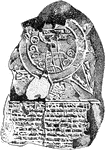
A Babylonian Map of the World
"A tablet of dark brown clay, much injured, dating from the 8th or 7th century B.C. The two large concentric…

An Egyptian Scribe
A statue of a man who recorded books and/or documents during the era of Ancient Egypt.
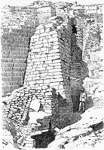
Excavations at Troy
"The great northeast tower of the sixth city. The stairs to the right date from the eighth city."—Webster,…

Aegean Snake Goddess
The sculpture of an ancient Snake Goddess. The artifact demonstrates typical Minoan female attire.

The Discus Thrower
Also known as Discobolus. The Discus Thrower is a famous, ancient bronze statue that demonstrates a…

Apoxyomenos
An ancient sculpture representing an athlete using a strigil to scrape sweat and dust off his body.

Temple of Neptune
"Paestum, the Greek Poseidonia, was a colony of Sybaris. The malarial atmosphere of the place led to…
Greek Soldiers in Arms
"From a Greek vase of about the time of the battle of Marathon."—Webster, 1913

The Mound at Marathon
"Near the southern extremity of the plain of Marathon rises a conical mound, 30 feet high. it covers…

An Athenian Trireme
An ancient ship used by Greeks and Romans. The ship has three rows of oars on each side, with a man…
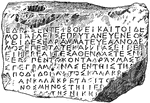
An Athenian Inscription
"A decree of the Council and Assembly dating from about 450 B.C."—Webster, 1913

Pnyx
"Shows the bema, or platform, from which orators addressed the assembled citizens."—Webster, 1913

Mourning Athena
"A tablet of Pentelic marble. Athena, leaning on her spear, is gazing with downcast head at a grave…
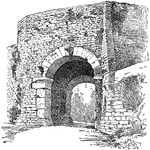
An Ertuscan Arch
"The Italian city of Volterra still preserves in the Porta dell' Arco an interesting relic of Ertuscan…

Suovetaurilia
"The relief pictures an ancient Italian sacrifice of a bull, a ram, and a boar, offered to Mars to secure…
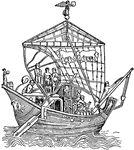
A Roman Freight Ship
"This ship lies besides the wharf at Ostia. In the afterpart of the vessel is a cabin with two windows.…

A Roman Aqueduct
"The Pont du Gard near Nimes (ancient Nemausus) in southern France. Built by the emperor Antoninus Pius.…

A Roman Temple
"The best preserved of Roman temples. Located at Nimes in southern France, where it is known as La Maison…
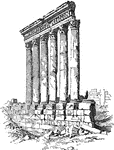
Temple of the Sun
"The ruins at Balbec in Syria lie amidst desolate mountains, forty miles from the sea. They consist…

Tomb of Theodoric at Ravenna
"The two-storied marble structure is capped by an enormous monolith weighing over 300 tons."—Webster,…

An Athenian Gravestone
"A relief on the tomb of a certain Hegeso. It represents a woman, seated, taking a jewel from a casket…


